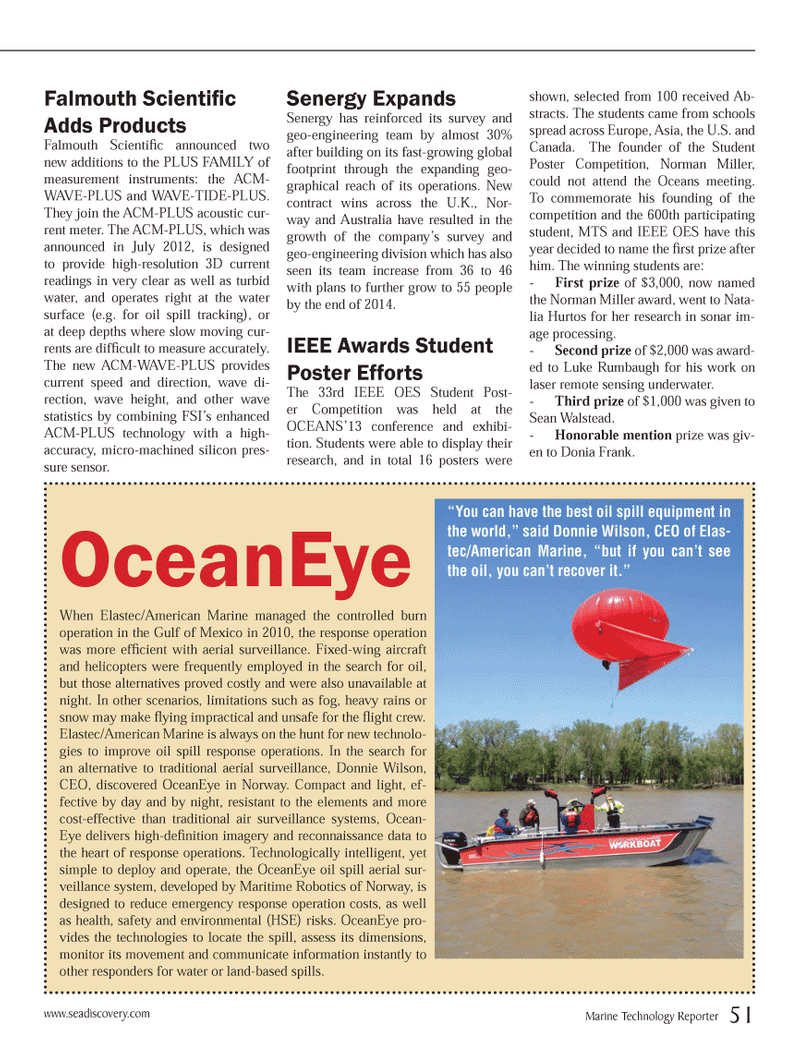
Page 51: of Marine Technology Magazine (October 2013)
Subsea Defense
Read this page in Pdf, Flash or Html5 edition of October 2013 Marine Technology Magazine
Falmouth Scienti Þ c Adds ProductsFalmouth ScientiÞ c announced two new additions to the PLUS FAMILY of measurement instruments: the ACM- WAVE-PLUS and WAVE-TIDE-PLUS. They join the ACM-PLUS acoustic cur- rent meter. The ACM-PLUS, which was announced in July 2012, is designed to provide high-resolution 3D current readings in very clear as well as turbid water, and operates right at the water surface (e.g. for oil spill tracking), or at deep depths where slow moving cur- rents are difÞ cult to measure accurately. The new ACM-WAVE-PLUS provides current speed and direction, wave di- rection, wave height, and other wave statistics by combining FSIÕs enhanced ACM-PLUS technology with a high- accuracy, micro-machined silicon pres- sure sensor. Senergy ExpandsSenergy has reinforced its survey and geo-engineering team by almost 30% after building on its fast-growing global footprint through the expanding geo- graphical reach of its operations. New contract wins across the U.K., Nor- way and Australia have resulted in the growth of the companyÕs survey and geo-engineering division which has also seen its team increase from 36 to 46 with plans to further grow to 55 people by the end of 2014. IEEE Awards Student Poster Efforts The 33rd IEEE OES Student Post-er Competition was held at the OCEANSÕ13 conference and exhibi- tion. Students were able to display their research, and in total 16 posters were shown, selected from 100 received Ab- stracts. The students came from schools spread across Europe, Asia, the U.S. and Canada. The founder of the Student Poster Competition, Norman Miller, could not attend the Oceans meeting. To commemorate his founding of the competition and the 600th participating student, MTS and IEEE OES have this year decided to name the Þ rst prize after him. The winning students are: - First prize of $3,000, now named the Norman Miller award, went to Nata- lia Hurtos for her research in sonar im-age processing.- Second prize of $2,000 was award- ed to Luke Rumbaugh for his work on laser remote sensing underwater. - Third prize of $1,000 was given to Sean Walstead. - Honorable mention prize was giv- en to Donia Frank.OceanEye When Elastec/American Marine managed the controlled burn operation in the Gulf of Mexico in 2010, the response operation was more efÞ cient with aerial surveillance. Fixed-wing aircraft and helicopters were frequently employed in the search for oil, but those alternatives proved costly and were also unavailable at night. In other scenarios, limitations such as fog, heavy rains or snow may make ß ying impractical and unsafe for the ß ight crew. Elastec/American Marine is always on the hunt for new technolo- gies to improve oil spill response operations. In the search for an alternative to traditional aerial surveillance, Donnie Wilson, CEO, discovered OceanEye in Norway. Compact and light, ef- fective by day and by night, resistant to the elements and more cost-effective than traditional air surveillance systems, Ocean- Eye delivers high-deÞ nition imagery and reconnaissance data to the heart of response operations. Technologically intelligent, yet simple to deploy and operate, the OceanEye oil spill aerial sur- veillance system, developed by Maritime Robotics of Norway, is designed to reduce emergency response operation costs, as well as health, safety and environmental (HSE) risks. OceanEye pro- vides the technologies to locate the spill, assess its dimensions, monitor its movement and communicate information instantly to other responders for water or land-based spills. ?You can have the best oil spill equipment in the world,? said Donnie Wilson, CEO of Elas-tec/American Marine, ?but if you can?t see the oil, you can?t recover it.?www.seadiscovery.com Marine Technology Reporter 51MTR #8 (50-64).indd 51MTR #8 (50-64).indd 5110/16/2013 11:59:29 AM10/16/2013 11:59:29 AM

 50
50

 52
52
